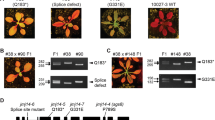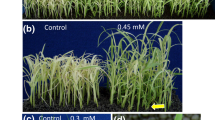Abstract
Epigenetic silencing of a bialaphos resistance (bar) gene in R1 progeny of a transgenic rice line was found to be meiotically stable since selfed (R2) progeny were also susceptible and the bar locus highly methylated. A high proportion of R2 seedlings germinated in the presence of 5-azacytidine (AzaC) were herbicide-resistant and also contained at least one unmethylated copy of the bar gene, further establishing the relationship between silencing and methylation. Restored bar gene expression was typically maintained for 20–50 days, but eventual methylation and silencing of the bar locus underscores the ability of the recipient genome to recognize and inactivate intrusive DNA.
Similar content being viewed by others
References
Armuganathan K, Earle ED: Nuclear DNA content of some important plant species. Plant Mol Biol Rep 9: 208–220 (1991).
Battraw M, Hall TC: Expression of a chimeric neomycin phosphotransferase II gene in first and second generation transgenic rice plants. Plant Sci 86: 191–202 (1992).
Birch RG, Franks T: Development and optimisation of microprojectile systems for plant genetic transformation. Aust J Plant Physiol 18: 453–469 (1991).
Buchholz WG, Connell JP, Kumpatla SP, Hall TC: Molecular analysis of transgenic rice. In: Foster G, Taylor S (eds) Methods in Molecular Biology: Plant Virology Protocols: From Virus Isolation to Transgenic Resistance, pp. 397–415. Humana Press, Totowa, NJ (1998).
Buchholz WG, Teng W, Wallace D, Ambler J, Hall TC: Production of transgenic rice (Oryza sativa subspecies japonica cv. Taipei 309). In: Foster G, Taylor S (eds) Methods in Molecular Biology: Plant Virology Protocols: From Virus Isolation to Transgenic Resistance, pp. 383–397. Humana Press, Totowa, NJ (1998).
Christensen AH, Quail PH: Ubiquitin promoter-based vectors for high-level expression of selectable and/or screenable marker genes in monocotyledonous plants. Transgen Res 5: 213–218 (1996).
Christou P: Transformation technology. Trends Plant Sci 1: 423–431 (1996).
D'Halluin K, Bonne E, Bossut M, De Deuckeleer M, Leemans J: Transgenic maize plants by tissue electroporation. Plant Cell 4: 1495–1505 (1992).
Dong J, Teng W, Buchholz WG, Hall TC: Agrobacterium-mediated transformation of Javanica rice. Mol Breed 2: 267–276 (1996).
Dorer DR: Do transgene arrays form heterochromatin in vertebrates? Transgen Res 6: 3–10 (1997).
Finnegan J, McElroy D: Transgene inactivation: Plants fight back! Bio/technology 12: 883–888 (1994).
Flavell RB: Inactivation of gene expression in plants as a consequence of specific sequence duplication. Proc Natl Acad Sci USA 91: 3490–3496 (1994).
Gordon-Kamm WJ, Spencer TM, Mangano ML, Adams TR, Daines RJ, Start WG, O'Brien JV, Chambers SA, Adams WR Jr., Willetts NG, Rice TB, Mackey CJ, Krueger RW, Kausch AP, Lemaux PG: Transformation of maize cells and regeneration of fertile transgenic plants. Plant Cell 2: 603–618 (1990).
Hart CM, Fischer B, Neuhaus J-M, Meins Jr F: Regulated inactivation of homologous gene expression in transgenic Nicotiana sylvestris plants containing a defense-related tobacco chitinase gene. Mol GenGenet 235: 179–188 (1992).
Hiei Y, Ohta S, Komari T, Kumashiro T: Efficient transformation of rice (Oryza sativa L.) mediated by Agrobacterium and sequence analysis of the boundaries of the T-DNA. Plant J 6: 271–282 (1994).
Hobbs SLA, Warkentin TD, DeLong CMO: Transgene copy number can be positively or negatively associated with transgene expression. Plant Mol Biol 21: 17–26 (1993).
Ishida I, Saito H, Ohta S, Hiei Y, Komari T, Kumashiro T: High efficiency transformation of maize (Zea mays L.) mediated by Agrobacterium tumefaciens. Nature Biotechnol 14: 745–750 (1996).
Jorgensen RA: Cosuppression, flower color patterns and metastable gene expression states. Science 268: 686–691 (1995).
Kilby NJ, Leyser MHO, Furner IJ: Promoter methylation and progressive transgene inactivation in Arabidopsis. Plant Mol Biol 20: 103–112 (1992).
Klein TM, Harper EC, Svab Z, Sanford JC, Fromm ME, Maliga P: Stable genetic transformation of intact Nicotiana cells by the particle bombardment process. Proc Natl Acad Sci USA 85: 8502–8505 (1988).
Klein TM, Kornstein L, Fromm ME: Genetic transformation of maize callus by particle bombardment and the influence of methylation on foreign gene expression. In: Gustafson JP (ed) Gene Manipulation in Plant Improvement, pp. 265–288. Plenum Press, New York (1990).
Kumpatla SP, Chandrasekharan MB, Iyer LM, Li G, Hall TC: Genome intruder scanning and modulation systems and transgene silencing. Trends Plant Sci 3: 97–104 (1998).
Kumpatla SP, Hall TC: Recurrent onset of epigenetic silencing in rice harboring a multicopy transgene. Plant J 14: 129–135 (1998).
Kumpatla SP, Teng W, Buchholz WG, Hall TC: Epigenetic transcriptional silencing and 5-azacytidine-mediated reactivation of a complex transgene in rice. Plant Physiol 115: 361–373 (1997).
Matzke MA, Matzke AJM: Differential inactivation and methylation of a transgene in plants by two suppressor loci containing homologous sequences. Plant Mol Biol 16: 821–830 (1991).
Matzke MA, Matzke AJM: How and why do plants inactivate homologous (trans)genes? Plant Physiol 107: 679–685 (1995).
Matzke MA, Matzke AJM, Mittelsten Scheid O: Inactivation of repeated genes –DNA–DNA interaction? In: Paszkowski J (ed) Homologous Recombination and Gene Silencing in Plants, pp. 217–307. Kluwer Academic Publishers, Dordrecht, Netherlands (1994).
McElroy D, Brettel RIS: Foreign gene expression in transgenic cereals. Trends Biotechnol 12: 62–68 (1994).
Meyer P, Heidmann I, Niedenhof I: Differences in DNAmethylation are associated with a paramutation phenomenon in transgenic petunia. Plant J 4: 89–100 (1993).
Meyer P: Understanding and controlling transgene expression. Trends Biotechnol 3: 332–337 (1995).
Mittelsten Scheid O, Paszkowski J, Potrykus I: Reversible inactivation of a transgene in Arabidopsis thaliana. Mol Gen Genet 228: 104–112 (1991).
Qu R, De Kochko A, Zhang L, Marmey P, Li L, Tian W, Zhang S, Fauquet CM, Beachy RN: Analysis of a large number of independent transgenic plants produced by the biolistic method. In Vitro Cell Devel Biol Plant 32: 233–240 (1996).
Rathore KS, Chowdhury VK, Hodges T: Use of bar as a selectable marker gene and for the production of herbicideresistant rice plants from protoplasts. Plant Mol Biol 21: 871–884 (1993).
Register JC III, Peterson DJ, Bell PJ, Bullock WP, Evans IJ, Frame B, Greenland AJ, Higgs NS, Jepson I, Jiao S, Lewnall CJ, Sillick JM, Wilson HM: Structure and function of selectable and non-selectable transgenes in maize after introduction by particle bombardment. Plant Mol Biol 25: 951–961 (1994).
Renckens S, De Greve H, Van Montagu M, Hernalsteens J-P: Petunia plants escape from negative selection against a transgene by silencing the foreign DNA via methylation. Mol Gen Genet 233: 53–64 (1992).
Riggs CD, Bates GW: Stable transformation of tobacco by electroporation: evidence for plasmid concatenation. Proc Natl Acad Sci USA 83: 5602–5606 (1986).
Santi DV, Garrett CE, B arr PJ: On the mechanism of inhibition of DNA-cytosine methyl transferases by cytosine analogs. Cell 33: 9–10 (1983).
Spencer TM, O'Brien JV, Start WG, Adams TR: Segregation of transgenes in maize. Plant Mol Biol 18: 201–210 (1992).
Sutton DW, Havstad PK, Kemp JD: Synthetic cryIIIA Bacillus thuringiensis improved for high expression in plants. Transgen Res 1: 228–236 (1992).
Vaucheret H: Promoter-dependent trans-inactivation in transgenic tobacco plants: kinetic aspects of gene silencing and gene reactivation. C R Acad Sci Paris Life Sci 317: 310–323 (1994).
Author information
Authors and Affiliations
Rights and permissions
About this article
Cite this article
Kumpatla, S.P., Hall, T.C. Longevity of 5-azacytidine-mediated gene expression and re-establishment of silencing in transgenic rice. Plant Mol Biol 38, 1113–1122 (1998). https://doi.org/10.1023/A:1006071018039
Issue Date:
DOI: https://doi.org/10.1023/A:1006071018039




